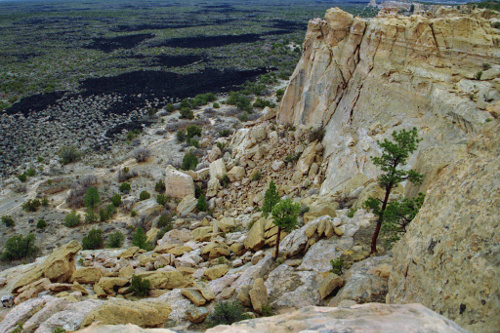<![CDATA[Hidden among the lava beds in New Mexico’s black-rock badlands, archaeologists have found what remains of a 900-year-old village which consists of over 120 individual sites, including everything from an 85 room great house to the faint remains of smaller houses. Named Las Ventanas (The Windows), it appears the community was somehow connected to the Ancestral Puebloan complex of Chaco Canyon, yet it contains qualities unseen anywhere else. Judging by the ceramic shards found at the site as well as other architectural clues, Las Ventanas appears to have been built at approximately the same time the culture centered at Chaco Canyon around 93 miles away (150 km) was at its peak - between the late eleventh century and the early twelfth century. Researchers discovered the Chacoan style great house was actually an elevated kiva, or tower kiva, which were chambers, typically built entirely or partially underground and used for religious ceremonies by the male Pueblo Indians. The kiva (and other structures) at Las Ventanas however, was built using the locally available lava rock instead of the sandstone which was typical of Chaco structures, reflecting the creativity of those living there. Paul Reed, who lead the research team, explained to the publication Western Digs that Las Ventanas was built on the southern edge of the Chacoan World between 1075 CE and 1125 CE and was part of a large group of sites known as Chacoan outliers. He also added that the people were most likely a local Pueblo community who had established ceremonial contact and trade ties with Chaco, and not migrants from Chaco Canyon itself. Another aspect unique to Las Ventanas is an intricate trail system worn into the surrounding lava. All told, there are more than 62 miles (100 km) of trails leading away from the open desert and into the lava field. With no particular destination, they simply taper off and then disappear in a manner similar to the unfinished roads radiating out of Chaco Canyon. Researchers believe the trails were built as ritual features themselves, to access various points within the lava bed – which is further supported by the smalls caches of items, including tools and ceramics, that have been found along a number of the paths. Many of these artifacts are believed to have been ritual offerings, suggesting the spiritual significance of the lava flow. It appears the people of Las Ventanas also had ties to other Pueblo groups as well. For example, they used materials and techniques associated with communities other than Chaco in making their ceramics. This has led researchers to conclude that the Chacoan World wasn’t a monolithic society where all the communities, over an area of 50,000 square miles (around the size of Ireland) looked the same, but rather a confederation of local groups. The El Malpais National Monument, where the sites are located, is sponsoring the research being done by Reed and his team. To date, they have completed the survey and mapping of over 4,000 acres of desert, much of it made possible by the advances in GPS/GIS technology. Image courtesy of Wikimedia Commons user: Brian W. Schaller ]]>
A Window Into a Chaco Canyon Community
